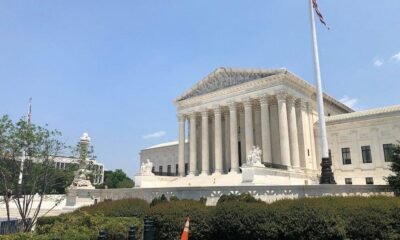Anferny Cly
Tribal Town Raises Alarm Over Expanding Uranium Mill Operations: ‘They Don’t Care About Us’

A school bus travels along State Route 191 in Bluff, Utah. The state road is part of the Pinyon Plain Mines approved uranium haul route to the White Mesa Uranium Mill in White Mesa, Utah. Photo by Shondiin Silversmith | Arizona Mirror
Residents of White Mesa, Utah, are increasingly anxious about the implications of uranium hauling through their community. Anferny Cly, a member of the Ute Mountain Ute Tribe, recalls a more carefree childhood spent watching semitrucks drive along State Route 191 without concern. Today, however, that sentiment has shifted dramatically.
“It kind of gets nerve-wracking,” Cly remarked, living a mere five miles from one of the few operating uranium mills in the country. His worries are compounded by the knowledge that uranium ore will soon be transported through his community to this mill.
The White Mesa Uranium Mill, situated on the ancestral lands of the Ute Mountain Ute Tribe, poses unique challenges for this close-knit community of approximately 300 members. Cly, now 25, reflects on the busy traffic along the highway, which is frequented by both workers and tourists. “When I see those large trucks, I know they might not be carrying anything innocuous,” he said.
The introduction of uranium ore transport from the newly active Pinyon Plain Mine in Arizona has raised significant alarm. Cly often finds himself questioning the safety of these hauls. “The placards indicating radioactive materials are sometimes small and poorly positioned,” he stated, which exacerbates his anxiety about potential risks.
Energy Fuels, the owner of the Pinyon Plain Mine, commenced uranium mining in early 2024 and began transporting ore to White Mesa in mid-July. The mill is the only fully licensed and operational conventional uranium mill in the United States. However, it also serves as a disposal site for radioactive waste from various sources across North America.
The Ute Mountain Ute Tribe has consistently raised concerns about the environmental impact of the mining activities, warning that air and water contamination could threaten their cultural heritage and future generations. In a region where natural resources are essential for survival, these worries feel particularly urgent.
Tens of trucks, heavily loaded with uranium ore, are expected to traverse the community daily. Cly’s mother, Yolanda Badback, shares her anxieties. “If something goes wrong, who will notify us? Who’s responsible for cleanup?” she questioned, emphasizing the lack of reassurance from state officials.
Despite their efforts to engage with environmental authorities, responses from the Utah Department of Environmental Quality have only deepened their sense of neglect. “If there’s an accident, we won’t even be informed first,” she lamented. Instead, nearby towns may receive priority notifications over the community most immediately affected.
Awareness and activism run deep within Cly’s family, with their roots stretching back to his great-grandfather’s efforts to oppose uranium mining. “This isn’t for our people,” Cly quoted, echoing his ancestor’s sentiments. Today, the family continues to champion the community’s concerns, organizing rallies and spiritual walks to voice their distress.
The mill’s presence has taken a toll on both the environment and the cultural fabric of the tribe. “Our sacred grounds have been destroyed,” Badback reiterated, recalling the once-abundant traditional herbs no longer found in the area due to the mill’s operations. Concerns about water contamination from the nearby aquifer remain at the forefront of their fight.
In contrast, Energy Fuels asserts that their operations adhere to the highest safety standards. Their claims are met with skepticism, as many residents have yet to receive direct communication about the haul’s logistics or safety protocols.
Badback summed up the community’s sentiments succinctly: “They don’t care about us Indigenous people.” As the trucks continue to make their way through White Mesa, fears of contamination and health risks loom large, igniting a fierce resolve among the community members to advocate for their rights and safety.


















